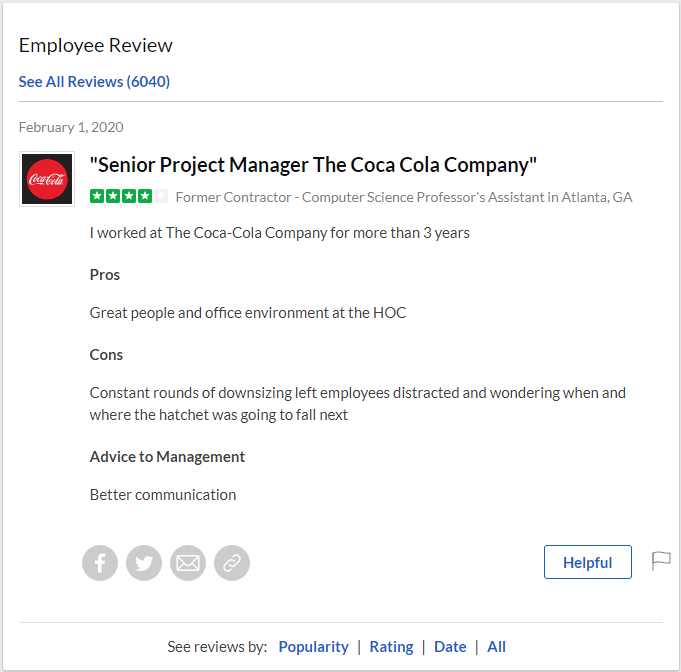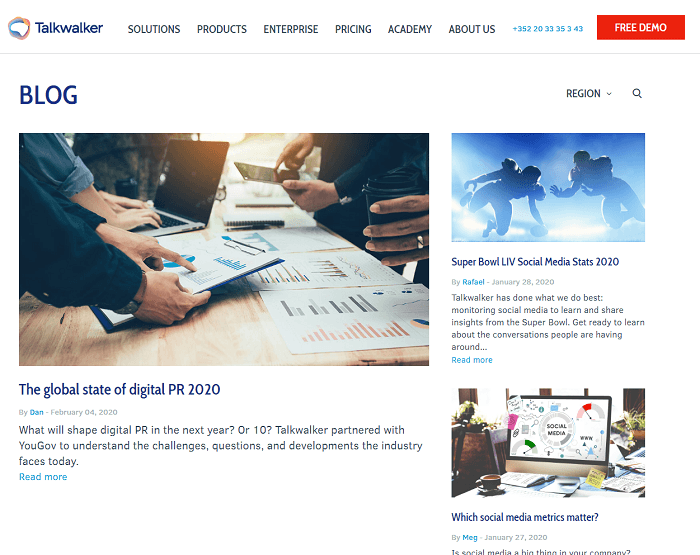10 crucial Social Data sources for Brand Monitoring Talkwalker
What social data should you be monitoring? Here's the top social media data sources you should be listening to for smart, data-driven marketing.
February 8, 2020

What are social media data sources?
Social data sources used to be the information you gathered from the numerous social media channels you use. Now, it's become more of a catch-all term, encompassing not just social media, but other sources - blogs, web analytics, reviews, etc., - that you should monitor to gather insights for data-driven business decisions.
Which social data sources should you measure?
Don’t assume that you have to use every social channel out there. You're in danger of spreading your time and budgets too thin, leaving you with little or no impact.
Comprehensive monitoring of your brand, and your competitors, will help you identify the channels your consumers are using. So you can target them efficiently, with content that consumers are happy to engage with.
Below are some of the biggest social media data sources you should monitor, how people are using them, and why you should be all over them.
Facebook is currently the largest social media platform in the world, with 2.41 billion monthly active users. Recently, it's adapted to be more community focused, with an increase in support for groups.
They’re working hard to promote groups further, with ads run during Super Bowl, and a increased focus on groups in the new Facebook design update.
Facebook’s promotional push for Groups.
Why you should use Facebook social data
Facebook offers the broadest audience, due to its wide appeal. The typical audience is around 18 to 34 (57% of total), but there’s still significant usage from under 18s and the 34 pluses.
And with an increased focus on groups, users are more topic-led, helping you identify the interests for specific target audiences.
What should you monitor on Facebook?
You should monitor Facebook Insights, to provide yourself with constant metrics related to your owned media, such as your audience engagement rates and demographics. Allowing you to adapt content to suit your followers.
Plus, competitive intelligence helps you identify the markets you’re missing, and provide inspiration for further content ideas. Make sure to monitor the pages of your direct competitors, as well as potential aspirational pages.
Rather than monthly active users, Twitter now reports on monetizable daily active users - 145 million in Q3 2019. The platform is all about speed - users engaging with stories as they happen, and adding their own insights to them. In a minimum number of words.
US Twitter users are generally more educated than the average US population, with the median age at 40.
It’s here you often see brands reacting the fastest. Reacting to major news stories within minutes of them happening.
Medical fondue, but no OREO emoji? https://t.co/4H1jh9XzwO
— OREO Cookie (@Oreo) January 30, 2020
Oreo newsjacked the latest emoji release announcement
The speed of the channel also makes it perfect for a means of customer support. It offers brands an opportunity for transparency (when people complain publicly), with the option to take major issues into direct messages to avoid damage.
Yet, when people do complain about a brand in a tweet, only 3% of those tweets include the brand handle.
Why you should use Twitter social data
Twitter offers a variety of ways for brands to monitor their mentions on Twitter. For the best, you need the Twitter Firehose. This is 100% of tweets in real-time.
That means no sampling, or estimates. You can get a complete overview of your brand with no missing social media data. Ensuring you don’t make mistakes based on guesstimations.
What should you monitor on Twitter?
Monitor your handles, but also create queries to monitor mentions of your brand name or products (to catch the 97% of hidden complainers from above).
Create a benchmark for your engagement levels, to help you see the impact of any new campaigns. And include share of voice, to see how your brand compares to the rest of the industry.
Instagram is one of the fastest growing social media channels, crossing one billion active members in June 2018. The visual platform has enabled everyone to show off their creative flair, with stunning photos of food, pets, and tropical destinations.
It was deemed to be the realm of celebrity influencers, requiring big audiences (and big money) to make an impact. More recently, people with more curated communities are getting great results with less reach, but much better engagement.
With an engagement rate of 3.4%, you don’t need a large audience to get great influencer engagement on Instagram.
Why you should use Instagram social media data
Not everything is about text. Instagram offers valuable visual insights into how your brand is shared online. A picture paints a thousand words, and in this case, it gives you a chance to see your audience engage with products, and provides details into how, why, and when they do.
The ‘gram is also more popular with younger demographics, with 36% of their advertising audience aged 13-24, compared to Facebook’s 30%. Perfect if you’re trying to target Gen Z.
What should you monitor on Instagram?
Instagram’s new APIs allow for a range of social data monitoring options. Monitoring both your own business account and competitors’ business accounts, gives you insights into content engagement rates, inspiring future posts.
Add in hashtag tracking, to monitor the key topics consumers follow, and understand the conversations happening in your industry.
LinkedIn is the world’s largest professional network. With 675+ million members, it’s used by people to connect businesses, promote company focused content, look for jobs, and build like-minded B2B communities.
Since being acquired by Microsoft in 2016, it’s had consistent growth, with many now seeing it as a lead-generation tool as well as a social network.
An example of engaging LinkedIn content driving action
Why you should use LinkedIn social data
If you’re promoting a B2B brand, then LinkedIn holds the ideal audience. They’re primed ready for business-related content (as long as it’s relevant), and the ability to define demographics based on business roles can help you identify your ideal customer.
What should you monitor on LinkedIn?
Monitoring your own page is vital. Not only will you be able to track the engagement rates of all your content, but also get a better understanding of your demographics. Knowing exactly which roles, industries, and functions you have as followers, can confirm that you’re engaging the audience you want to target. Or identify who’s missing.
Audit you social media sources
Sina Weibo
With 252 million of daily active users, Sina Weibo is the most popular micro-blogging platform in China. Much like Twitter, it’s a quick engagement platform, with 94% of users accessing it from a mobile device.

Consumers engage with brands across the globe. Sina Weibo ensures you can monitor places other social media channels can’t reach
Why you should use Sina Weibo social data
Due to the great firewall of China, other traditional social networks like Facebook and Twitter are used significantly less. Yet, China represents 18.5% of the global population, so by excluding the region from your social listening, you miss a large potential customer base.
Sina Weibo opens up this region with insights into how consumers engage with brands, celebrities and each other.
What should you monitor on Sina Weibo?
Brand mentions can be tracked effectively on Weibo, to help you understand the conversations happening there around your products. Sentiment is also important to track, to identify brand saturation throughout a focused community.
YouTube
1 billion hours of videos are watched everyday on YouTube, which disrupts the boundary between social channel and entertainment provider.
With the rise of streaming services, YouTube has adapted its model over recent years, adding live streaming, a YouTube Premium service for ad-free viewing, and producing YouTube Originals tv series and films.
The platform offers something for everyone, enticing a broad demographic of users with a wide range of interests.
YouTube Rewind - a recap of the best videos from 2019
Why you should use YouTube social data
If there’s a hobby or interest, you'll find content for it on YouTube. And communities surrounding that content. This can help you identify audiences that would be ideal for your brand, and the topics that they’re involved in.
What should you monitor on YouTube?
Look for both passive and active engagement on your videos and those mentioning your brand. There’s a big difference between people who like/dislike a video, and those driven enough to leave a comment (check the sentiment there too).
Influencer marketing is also big on the channel. Look for the content creators driving engaging content, and building active communities in your industry. And look for the videos that come up top in searches related to your brand - they’re likely to come top in Google searches too.
Review sites
Never underestimate the power of reviews. Nearly 91% of people think reviews are important enough to sway their purchasing decision. While 90% said user-generated content influenced their purchasing decision.
They’re a powerful medium that can have a positive (or negative) impact on your potential clients, so they’re essential to watch.

Glassdoor offers employees the opportunity to review their own company...
Why you should use review data sources
No matter your industry, there will be a review site that’s made for you. From B2B sites like G2, holiday specialists like Tripadvisor, or reviews that are incorporated into Amazon’s marketing strategy, every day consumers are providing you with valuable product feedback. Not just for your brand, but for your competitors too.
This conversational data can highlight product pain points, helping you shape more targeted content and campaigns.
What should you monitor from reviews?
The 3 big metrics here are mentions, sentiment, and topics. Monitor mentions regularly alongside sentiment to look for spikes. These will quickly flag an issue you may not have spotted elsewhere.
While topic clouds will highlight the conversation people are having in your reviews, helping you identify the issues you need to resolve.
Blogs, news, online mentions
With around 70 million blog posts per month, and another 144 million online news stories, this is where the longform stories about your brand are formed.
That’s a lot of content. Yet consumers spend 3 times as long reading blogs than they do reading emails. They’re a significant part of your customer information consumption, so must be included in the mix.

My favorite blog #NotBiased.
Why you should use blog and news data sources
Up to now, most of your brand mentions will be included in short-form content. Tweets, quick reviews, and such, don’t give authors the opportunities to analyze your product or brand in depth.
Blogs give people the word count to provide a thorough review. Which can be beneficial (as they reflect on all your unique features) or detrimental (as they bring to light all the flaws or issues you may not want revealing).
While news stories add prestige to a brand - though don’t fall into the trap of thinking all news is good news.
What should you monitor from blogs and news?
Tracking the mentions of your brand through a social listening platform will gather data from blogs and news from across the world. The most important metric here is sentiment: is it a good or bad mention.
Alexa page views will show you how far that story will have reached. And for news stories, check whether you’re getting more valuable headline mentions or in-story ones.
Identify which blogs to monitor
Brand logos
Up to now, we’ve mostly looked at textual monitoring - looking at written mentions of your brand online. But what about images? People are sharing your brand logos in pictures and videos every day, and you should be monitoring how they’re used.
Image and video recognition detects 300% more brand mentions than text monitoring alone.By not tracking your brand images, you’ll miss a significant share of your brand’s picture online.
IKEA was spotted in this video, even though it wasn’t mentioned in the same post.
Why you should use image and video analytics data
80% of brands detected in images didn’t include a brand mention in the associated text. That’s 80% of your brand awareness missed unless you include visual analytics.
It’s also a great way to see your brand in action. How people interact with it, where they are when they use it, what other brands are they associating it with. These visual insights build a stronger identity of your consumers and their habits.
What should you monitor with image and video analytics?
Videos and images should be tracked as any other mention. Look for engagement, topics, sentiment, and conversations.
Also, analyze the objects, scenes and other brands in the same images, to get a stronger understanding of how your consumers engage with it.
Web metrics
So far, we’ve looked at external data. What about internal? For effective monitoring, you should include metrics from your own website to see how your audience is growing, and whether your other social efforts impact it.
Why you should use website metrics data
For social media marketing, your customer journey will lead consumers to your website at some point - and as you can control it, you can measure exactly when, why and how consumers are using it.
What should you monitor with website metrics?
SEO keywords are important. The more relevant ones you have, the higher the ranking, the more organic traffic you can drive. Monitor your own, and do competitor analysis to jump on the ones you may be missing.
From there, you want to monitor the journey. Time on page, sessions, new users and conversions can all identify if your website is working effectively, or if potential clients are fleeing before they’re hooked.
Bounce rate also helps to track whether your users are jumping out of your sites, or onto other pages.
More social media data sources
Of course, this isn’t an extensive list. New platforms are launched all the time, so keep an eye out for the social data they bring and the opportunities you can get from it.
Monitoring the best social media data sources are key for data-driven decision making. My campaign playbook includes more examples of insights gathered from social data, to help you understand your industry, competitors, and consumers better.

